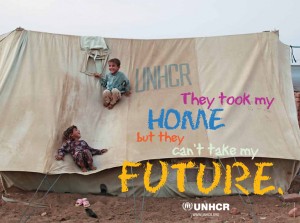I hope we can use this day to honour the courage and resilience of the millions of refuges around the world who push forward each and every day with the hope that tomorrow might bring a return home or the hope of a better life. I certainly intend to remain committed to making that hope a reality.~ Bill Clinton
As millions of people around the US were celebrating Father’s Day many people around the globe were marking World Refugee Day on Sunday. Let’s get down to the brass tacks: Migrants, especially economic migrants, choose to move in order to improve their lives and the lives of their families. Refugees have to move if they are to save their lives or preserve their freedom. Its all about survival. If other countries do not let them in, and do not help them once they are in, then they may be condemning them to death – or to a life with out rights.
Annual figures released Tuesday by the UN refugee agency show that some 43.3 million people were forcibly displaced worldwide at the end of 2009, the highest number of people uprooted by conflict and persecution since the mid-1990s. Why so many? Where are they ,you maybe asking? Grab a map and lets take a quick trip– conflicts like those in Afghanistan, Somalia and the Congo show no signs of being resolved anytime soon. Conflicts that had appeared to be ending or were on the way to being resolved, such as in southern Sudan or in Iraq, are stagnating and do not look like they will be resolved anytime soon. Oh and now lets add Kyrgyzstan to the picture. An estimated 300,000 people have had to flee their homes and seek shelter elsewhere in the country. This is in addition to some 100,000 people who have fled alreeady fled to neighbouring Uzbekistan since Ju
The international community has to do more for the forcibly displaced. In any refugee population, approximately 50 percent of the uprooted people are women and girls. Stripped of the protection of their homes, their communities and their family structure, females are often particularly vulnerable.
Let’s be clear, not every Refugee is the same.
A refugee is a person who (according to the formal definition in article 1A of the UN Convention), “owing to a well-founded fear of being persecuted for reasons of race, religion, nationality, membership of a particular social group, or political opinion, is outside the country of his nationality, and is unable to or, owing to such fear, is unwilling to avail himself of the protection of that country”.
Nationality is a legal bond between a state and an individual, and statelessness refers to the condition of an individual who is not considered as a national by any state. Although stateless people may sometimes also be refugees. Statelessness is a problem that affects an estimated 12 million people worldwide.
Internally displaced people, or IDPs, are often wrongly called refugees. Unlike refugees, IDPs have not crossed an international border to find sanctuary but have remained inside their home countries. Even if they have fled for similar reasons as refugees (armed conflict, generalized violence, human rights violations), IDPs legally remain under the protection of their own government – even though that government might be the cause of their flight. At the end of 2008, there were an estimated 26 million IDPs around the world in 22 countries, including the three with the largest IDP populations – Sudan, Colombia and Iraq.
For many people forced from their homes, a voluntary return home in safety and dignity marks the successful end to the trauma. Only a small number of refugees have the opportunity to be resettled to third countries or to be locally integrated into their host societies. Over the years many NGO’s have managed numerous large-scale voluntary repatriation programmes returned brought many millions of refugees home. In Afghanistan alone, some 5 million refugees have been turned into returnees when they had the opportunity to return home.
Whether you are a Honduran teenager fleeing homophobia or Congolese elder desperately trying to start a new life all alone in a strange land after escaping conflict or a woman from Afghanistan who has walked the long journey into exile having to engage in “survival sex” to feed her children – even after reaching an apparent place of safety.
We must not forget them or the despair of their displacement. Each of the statistics given in this post is a story– a human story of loss and survival of hope and ambition –of strength. Every one of these statistics has a face. So today let’s remember their struggle and honor their courage. They can take their homes, but not their futures.


